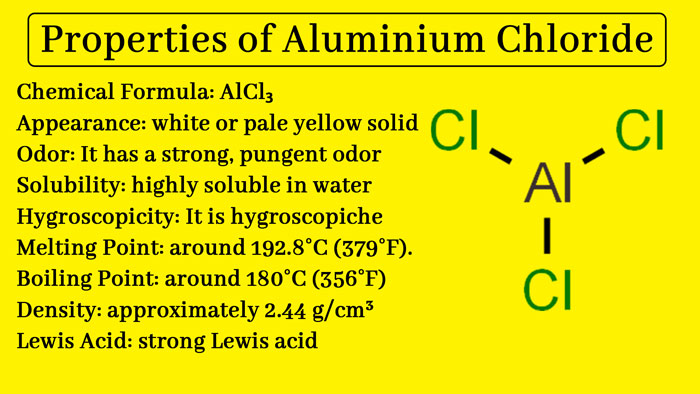Anhydrous Aluminium Chloride(AlCl3): Properties, Structure, Uses
- Aluminium Oxide: Al2O3
- Aluminium Hydroxide: Al(OH)3
- Sodium Meta-aluminate: NaAlO2
- Aluminium Sulfate: Al2(SO4)3
Anhydrous aluminium chloride is obtained by heating the dry chlorine metal or dry hydrochloric acid gas to the hot aluminium metal and evaporating the vapor.
2Al + 3Cl2 → 2AlCl3
2Al + 6HCl → 2AlCl3 + 3H2
Anhydrous aluminium chloride is also obtained when dry chlorine gas flows in a hot mixture of alumina and coke. This method is used on an industrial scale.
Al2O3 + 3C + 3Cl2 → 3CO + 2AlCl3
Method of preparation of hydrogen aluminium chloride: Aluminium oxide, aluminium hydroxide or aluminium metal is heated in dilute hydro acid to obtain alumina chloride solution. Upon washing, crystals of hydrogen alumina chloride are obtained. Its formula is AlCl3.
Al2O3 + 6HCl → 3H2O + 2AlCl3
2Al(OH)3 + 6HCl → 6H2O + 2AlCl3
2Al + 6HCl → 3H2 + 2AlCl3
AlCl3 + 6H2O → AlCl3.6H2O
It cannot be obtained by heating alkaline aluminium chloride. Anhydrous alumina chloride is not obtained by heating the hydrogen alumina chloride.
2AlCl3.6H2O → Al2O3 + 6HCl + 9H2O
Physical Properties
It is a white colored crystalline substance. It is a deliquescent substance.
The substances that soak up moisture and water are called Hygroscopic Substances. Hygroscopic solid which absorbs air or moisture to form a saturated solution, ie gets wet, is called Seliquescent Material.
Chemical Properties
Action with water: It forms an aqueous solution when exposed to water or moisture. It also causes water decomposition when exposed to water or moisture.
AlCl3 + 3H2O ⇌ Al(OH)3 + 3HCl
Due to water decomposition, its aqueous solution is acidic and due to the formation of HCl on exposure to moisture, smoke keeps coming out of it.
On evaporation of its aqueous solution, Its crystals are obtained.
AlCl3 + 6H2O → AlCl3.6H2O
Absorption of ammonia: It absorbs ammonia and makes it additive.
AlCl3 + 6NH3 → AlCl3.6NH3
Reaction of dilute NH4OH: Adding dilute NH4OH solution to aluminium chloride solution yields a mild white precipitate of aluminium hydroxide, which gives alumina (Al2O3) upon heating and aluminium sulphate when dissolved by adding H2SO4.
AlCl3 + 3NH4OH → 3NH4Cl + Al(OH)3
2Al(OH)3 → Al2O3 + 3H2O
2Al(OH)3 + 3H2SO4 → Al2(SO4)3 + 3H2O
Reaction of NaOH: By adding caustic soda solution to aluminium chloride solution, a precipitate of aluminium hydroxide is obtained, which dissolves in excess of caustic soda to form sodium meta-aluminate.
AlCl3 + 3NaOH → 3NaCl + Al(OH)3
Al(OH)3 + NaOH → 2H2O + NaAlO2
Aluminium Chlorid Uses
- It serves as a catalyst in friedel crafts reaction.
- Used to purify mineral oils.
- Cotton spinning and cotton lubriate are used.
- A mixture of AlCl3 and MgO is used to fill teeth, to add broken clay pots, and to make floors.
- liquid AlCl3 is used as a paint bond in dyeing and printing.
The evaporation density of anhydrous aluminium chloride at 400°C has been found to be 133. On this basis, its formula is Al2Cl6. The composition formula of anhydrous aluminium chloride is as follows.

According to the above structure formula, each aluminium atom binds to three chlorine atoms co-conjugated and one chlorine atom is joined by a cohesive bond. Chlorine atoms form a tetrahedral shape around each aluminium atom.
The vapor density of anhydrous aluminium chloride decreases with the increase in heat and its formula becomes AlCl3 at about 800°C. Aluminium chloride is often represented by this formula. Anhydrous aluminium chloride merges with organic solvents such as: alcohol, acetone, ether and carbon tetrochloride due to the presence of cohesive binds and does not conduct electricity in the molten state.
